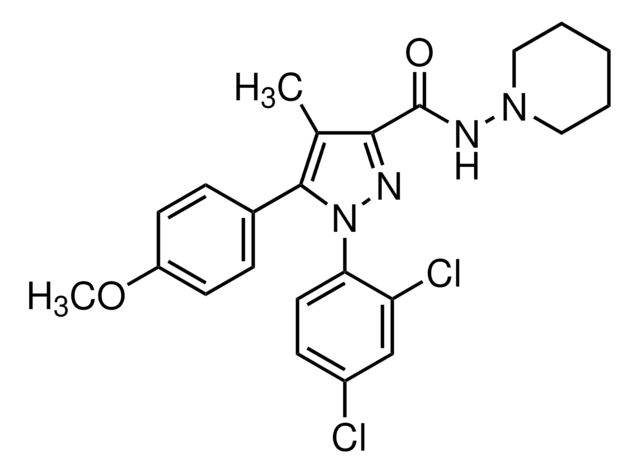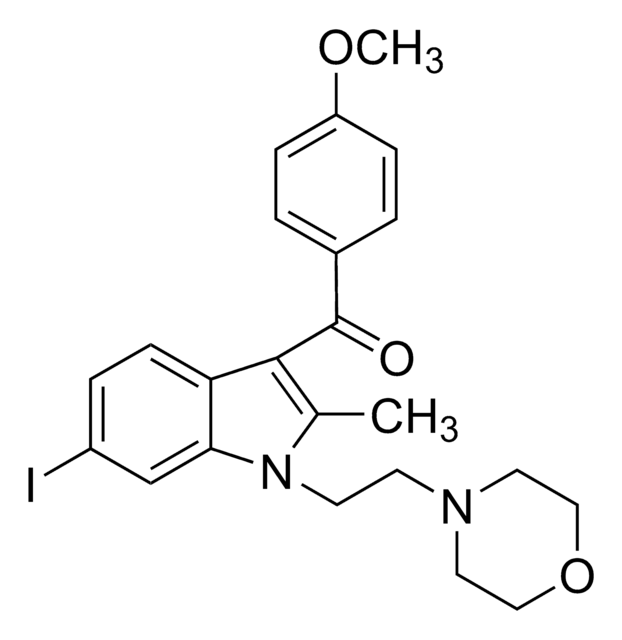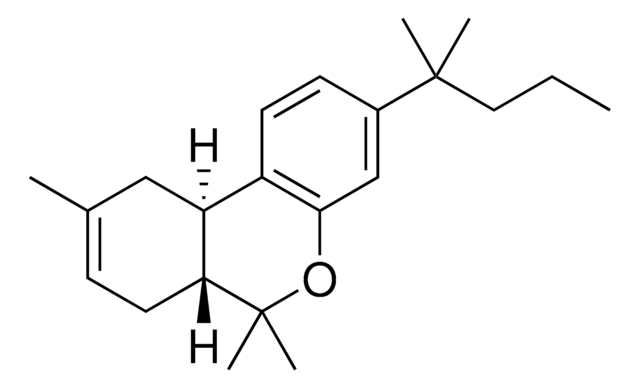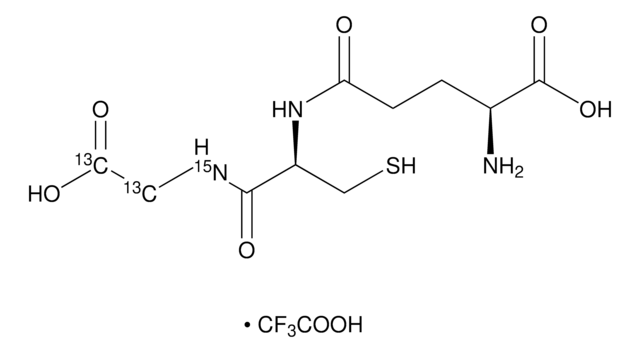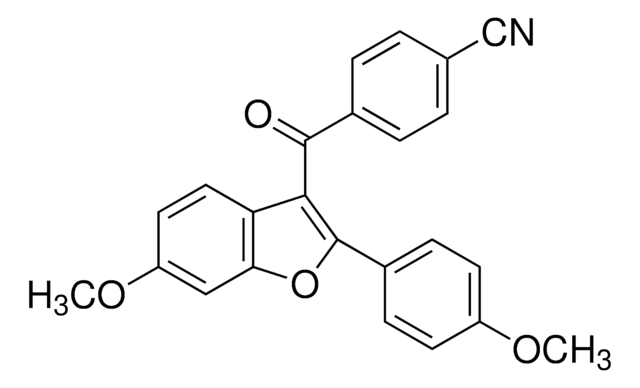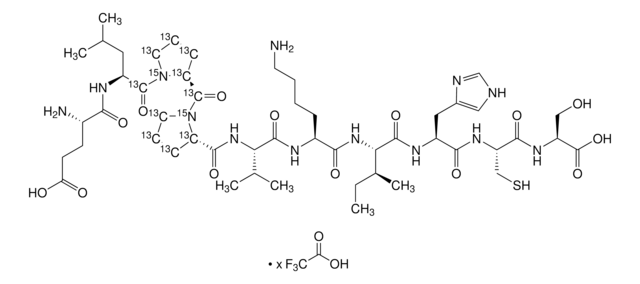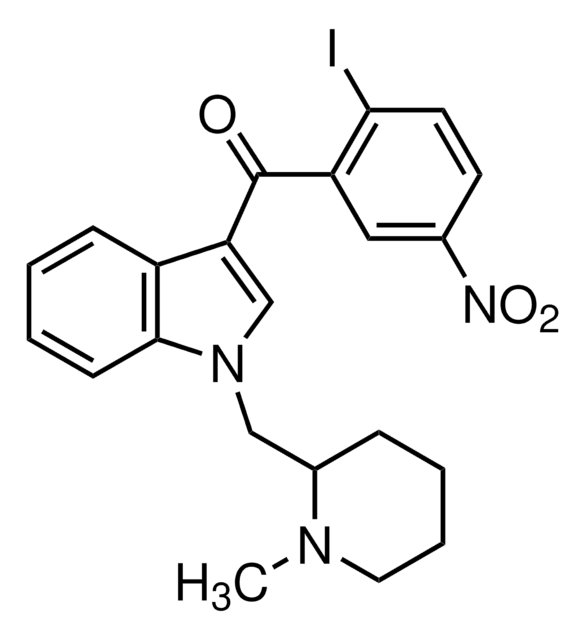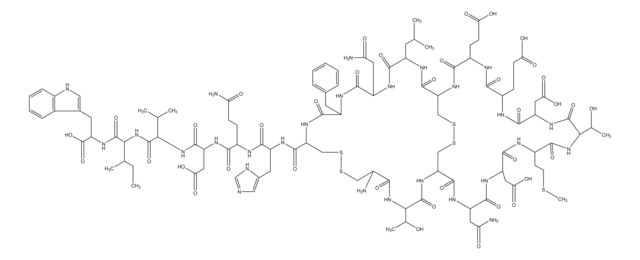SML1804
AM4113
≥98% (HPLC)
Synonym(s):
5-(4-Chlorophenyl)-1-(2,4-dichlorophenyl)-4-methyl-1H-pyrazole-3-carboxamide
Sign Into View Organizational & Contract Pricing
All Photos(1)
About This Item
Empirical Formula (Hill Notation):
C17H12Cl3N3O
CAS Number:
Molecular Weight:
380.66
UNSPSC Code:
12352200
PubChem Substance ID:
NACRES:
NA.77
Recommended Products
Quality Level
Assay
≥98% (HPLC)
form
powder
color
white to brown
solubility
DMSO: 2 mg/mL, clear (warmed)
storage temp.
2-8°C
SMILES string
ClC1=CC(Cl)=C(N2C(C3=CC=C(Cl)C=C3)=C(C)C(C(N)=O)=N2)C=C1
Biochem/physiol Actions
AM4113 is a Cannabinoid CB-1 neutral antagonist. AM4113 reduced reward and reinstatement of drug-seeking behavior, reducing cue-induced reinstatement in monkeys trained to self-administer cocaine.
AM4113 is a pyrazole-3-carboxamide analog of rimonabant (SR141716A). In rats, it suppresses food-motivated behaviors and food intake, thereby reducing weight gain without inducing nausea. AM4113 has poor oral bioavailability. Therefore, it may not act as an effective appetite suppressant in humans.
Hazard Statements
Precautionary Statements
Hazard Classifications
Aquatic Chronic 4
Storage Class Code
11 - Combustible Solids
WGK
WGK 3
Flash Point(F)
Not applicable
Flash Point(C)
Not applicable
Certificates of Analysis (COA)
Search for Certificates of Analysis (COA) by entering the products Lot/Batch Number. Lot and Batch Numbers can be found on a product’s label following the words ‘Lot’ or ‘Batch’.
Already Own This Product?
Find documentation for the products that you have recently purchased in the Document Library.
Charles W Schindler et al.
Neuropsychopharmacology : official publication of the American College of Neuropsychopharmacology, 41(9), 2283-2293 (2016-02-19)
Nicotine, the main psychoactive component of tobacco, and (-)-Δ(9)-tetrahydrocannabinol (THC), the main psychoactive ingredient in cannabis, play major roles in tobacco and marijuana dependence as reinforcers of drug-seeking and drug-taking behavior. Drugs that act as inverse agonists of cannabinoid CB1
K S Sink et al.
Pharmacology, biochemistry, and behavior, 91(3), 303-306 (2008-08-16)
Drugs that interfere with cannabinoid CB1 transmission suppress food-motivated behaviors, and may be clinically useful as appetite suppressants. Several CB1 receptor inverse agonists, such as rimonabant and AM251, as well as the CB1 receptor neutral antagonist, AM4113, have been assessed
Sherrica Tai et al.
Psychopharmacology, 232(15), 2751-2761 (2015-03-17)
Previous reports shows rimonabant's inverse properties may be a limiting factor for treating cannabinoid dependence. To overcome this limitation, neutral antagonists were developed, to address mechanisms by which an inverse agonist and neutral antagonist elicit withdrawal. The objective of this
Brian D Kangas et al.
The Journal of pharmacology and experimental therapeutics, 344(3), 561-567 (2013-01-05)
Cannabinoid receptor 1 (CB(1)) inverse agonists (e.g., rimonabant) have been reported to produce adverse effects including nausea, emesis, and anhedonia that limit their clinical applications. Recent laboratory studies suggest that the effects of CB(1) neutral antagonists differ from those of
T U C Järbe et al.
Pharmacology, biochemistry, and behavior, 91(1), 84-90 (2008-07-22)
We examined open-field effects in rats of the cannabinoid 1 receptor (CB1R) agonist WIN55,212-2 (WIN; 3 mg/kg) and its interaction with the CB1R putative neutral antagonist AM4113 (0.3 to 3 mg/kg). Separate studies examined AM4113 alone (0.3 to 5.6 mg/kg).
Our team of scientists has experience in all areas of research including Life Science, Material Science, Chemical Synthesis, Chromatography, Analytical and many others.
Contact Technical Service